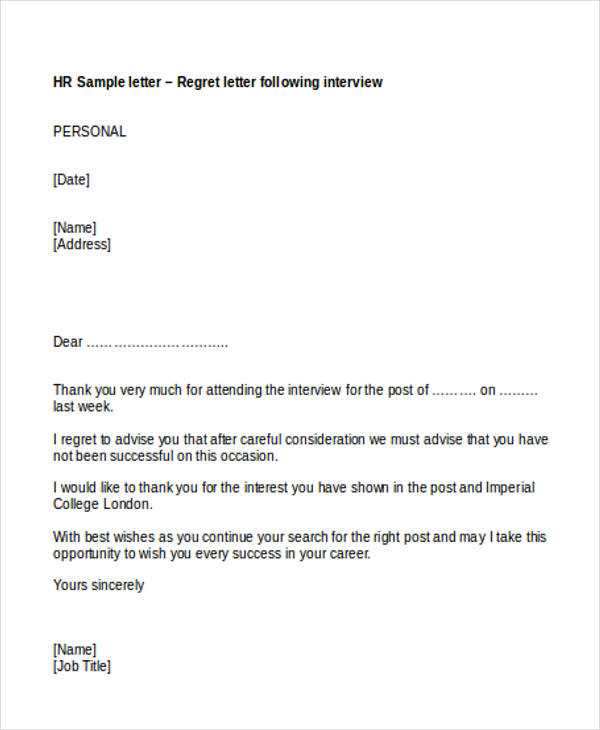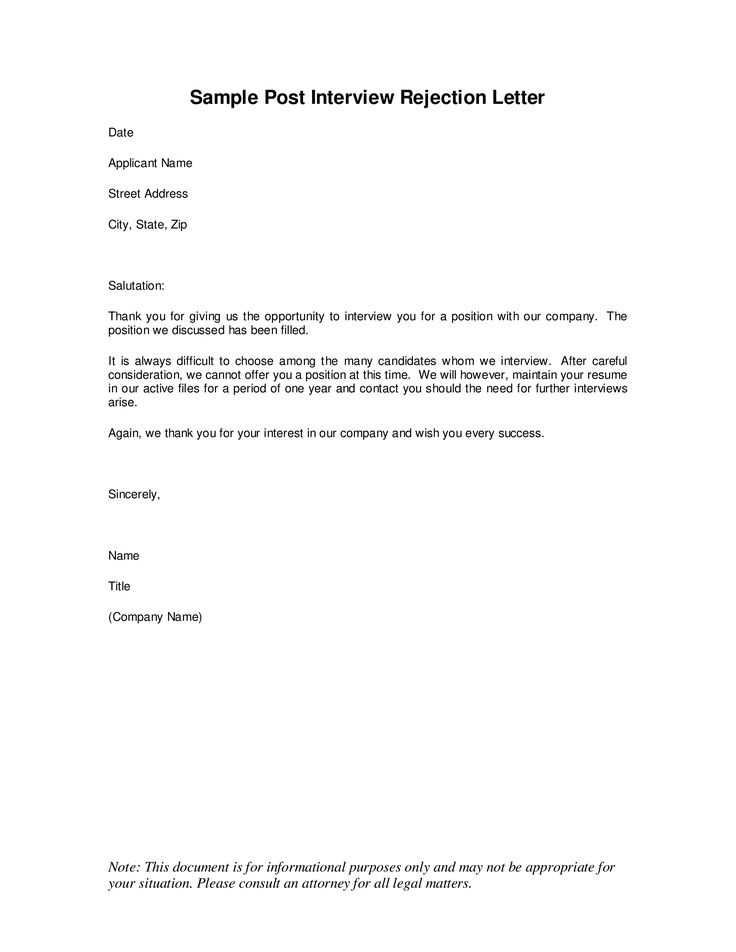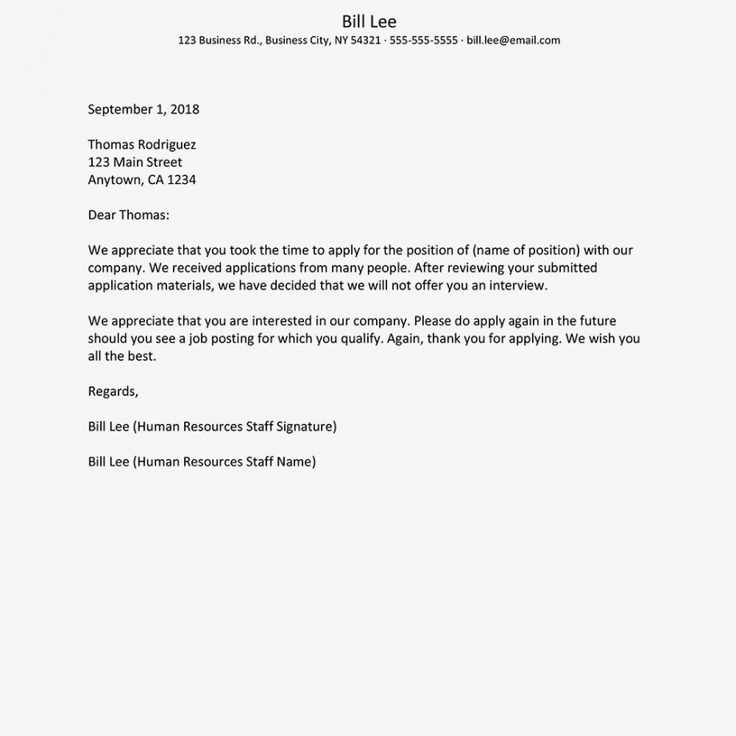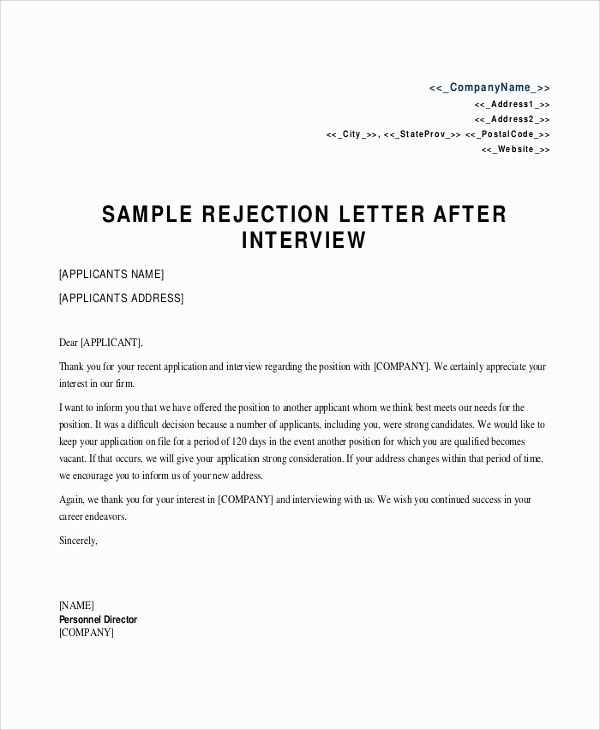Job Interview Rejection Letter Template for Employers

Delivering unfavorable news to candidates after a selection process can be a challenging task. It is crucial to convey the decision with respect, clarity, and professionalism, ensuring the individual feels valued despite the outcome.
While the conversation can be uncomfortable, taking a thoughtful approach to communication can help preserve relationships and maintain a positive reputation for your organization. A well-crafted response can leave a lasting impression and encourage candidates to remain interested in future opportunities.
In this article, we explore how to write a professional message that strikes the right balance between honesty and empathy. By following certain guidelines, you can ensure that your communication reflects your organization’s values and leaves candidates with a positive impression, even in the face of disappointment.
Importance of Sending a Rejection Letter

Clear communication is essential in any professional setting, especially when delivering a negative decision to an individual. Providing timely and respectful feedback can help maintain a positive image for your organization and foster goodwill among potential future candidates.
Failure to notify candidates about the outcome of the selection process may lead to frustration and confusion. It can also reflect poorly on your business, giving the impression of disorganization or lack of professionalism.
On the other hand, offering a thoughtful response ensures that individuals are treated with respect. It provides them with closure and an opportunity for growth, all while reinforcing your commitment to transparency and fairness in your hiring process.
Key Elements of a Professional Letter

When crafting a response to inform a candidate of the decision, it’s essential to strike the right balance between professionalism and empathy. The tone should be respectful and considerate, while the content must be clear and direct.
Several key components contribute to a well-structured message. Each element should be carefully considered to ensure that the overall communication reflects the professionalism of your organization and maintains a positive relationship with the recipient.
| Element | Description |
|---|---|
| Opening Statement | Start with a polite and appreciative greeting to acknowledge the candidate’s effort. |
| Clear Decision | State the decision clearly to avoid any confusion and to respect the recipient’s time. |
| Encouragement | Offer encouragement and emphasize the candidate’s strengths, even if they were not selected. |
| Closing Remarks | End on a positive note, keeping the door open for future opportunities and thanking them once again. |
Each of these components plays an important role in ensuring that the recipient feels respected and valued, even in the face of a negative outcome.
Best Practices for Writing Rejections

When informing someone of a negative outcome, it’s crucial to do so in a way that maintains professionalism and respects the individual’s effort. A well-written response can help preserve the candidate’s dignity and ensure your organization’s reputation remains intact.
There are several best practices that can guide you in crafting a considerate and effective message. These tips will ensure that your communication is both respectful and clear, avoiding any unnecessary misunderstandings or hard feelings.
- Be Prompt: Send the message as soon as a decision is made, so the candidate doesn’t remain in uncertainty.
- Personalize the Message: Address the individual by name and reference specific details, such as their qualifications or the role they applied for, to make the response feel more personal and less generic.
- Keep it Brief but Polite: Provide enough information to explain the decision without unnecessary elaboration. Be concise while maintaining a polite tone.
- Express Gratitude: Acknowledge the effort and time the individual spent in applying, showing appreciation for their interest in your organization.
- Provide Constructive Feedback (Optional): If appropriate, offer feedback that could help the candidate improve in future applications. Be specific and constructive rather than overly critical.
- Encourage Future Applications: Let the candidate know that they are welcome to apply for other roles in the future, fostering a positive relationship for potential future opportunities.
Following these guidelines will help ensure that the message is clear, respectful, and professional, minimizing any negative impact on the recipient while maintaining the integrity of your organization.
How to Maintain a Positive Tone
Delivering disappointing news requires careful attention to the tone of your message. Maintaining a positive tone ensures that the individual feels respected and valued, even when the outcome is not what they hoped for. This approach helps soften the blow while keeping the communication professional and empathetic.
To achieve this, focus on using language that is both encouraging and respectful. Even though the news may not be what the candidate expects, it’s important to leave them with a sense of appreciation for their effort and qualifications.
- Use Polite Language: Phrases like “we appreciate your time” or “thank you for your interest” show respect for the individual’s efforts.
- Avoid Negative Phrasing: Instead of saying “unfortunately, you were not selected,” rephrase it as “after careful consideration, we have chosen to move forward with other candidates.”
- Express Gratitude: Acknowledge the candidate’s application and the time they spent preparing, making sure they feel appreciated regardless of the outcome.
- Offer Encouragement: Reinforce that the decision was difficult and express confidence in their abilities. This helps soften the message and provides motivation for future endeavors.
- Keep the Door Open: Let them know they are welcome to apply again for other roles, which helps foster a long-term, positive relationship with the individual.
By focusing on these strategies, you can ensure that even difficult news is delivered in a way that upholds professionalism and maintains a positive atmosphere, leaving candidates with a positive impression of your organization.
When to Send the Rejection Letter
Timing plays a critical role when communicating a decision to a candidate. Sending a response at the right moment can help manage expectations and maintain a positive relationship with the individual, even if the news is disappointing.
It’s important to notify candidates as soon as a decision has been made. Delaying this communication can lead to frustration and confusion, as candidates may be left in limbo while awaiting feedback.
Ideal Timing
- Send Immediately After a Decision: Once a decision has been finalized, send the message promptly to ensure transparency and respect for the candidate’s time.
- Avoid Long Delays: Waiting for too long can create uncertainty. Aim to send the response within a few days of finalizing the decision.
What to Consider
- Internal Processes: If there are internal steps or approvals before the final decision is communicated, ensure these are completed quickly to avoid unnecessary delays.
- Respect Candidate’s Time: Candidates invest time in preparing and participating, so timely feedback shows that you value their effort, regardless of the outcome.
By ensuring your response is sent in a timely manner, you demonstrate professionalism and respect, which can help maintain a positive relationship with the candidate for future opportunities.
Common Mistakes to Avoid in Rejections
Delivering disappointing news is never easy, and mistakes in the process can leave a negative impression on the recipient. Certain missteps can harm relationships, damage your organization’s reputation, and cause unnecessary frustration for the individual. It’s essential to be mindful of common errors when crafting such responses.
Avoiding these common pitfalls ensures that your message remains professional, respectful, and clear, even when the outcome isn’t as expected.
- Being Too Vague: A lack of clarity in the message can lead to confusion and frustration. Always ensure the purpose of your communication is clear and straightforward.
- Using Negative Language: Harsh wording or overly blunt phrases can come across as unprofessional. Focus on neutral or positive language to avoid discouraging the individual.
- Delaying the Response: Postponing the notification can leave the individual uncertain and anxious. Sending the response promptly shows respect for their time and effort.
- Not Personalizing the Message: Generic, impersonal messages feel cold and dismissive. Always aim to add a personal touch to show you’ve given careful consideration to their application.
- Offering No Feedback: While not always necessary, constructive feedback can help candidates understand areas for improvement. Avoid providing no explanation at all, especially when it’s requested.
- Ignoring Future Opportunities: Failing to encourage future engagement can close doors. Let the candidate know they are welcome to apply for other roles within your organization.
By being mindful of these common mistakes, you can ensure that your communication is both professional and considerate, leaving candidates with a positive impression despite the outcome.